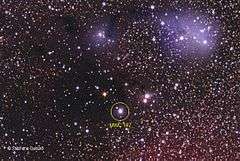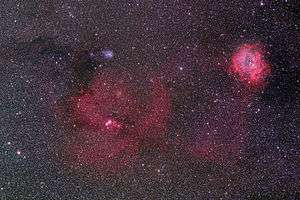HD 259431
HD 259431 (MWC 147 or V700 Monocerotis) is a young stellar object in the constellation of Monoceros.
Location of HD 259431 (circled) near the bluish IC 447 nebulosity. NGC 2264 is below (west) and the Rosette Nebula on the right (south). Credit: ESO/S. Guisard | |
| Observation data Epoch J2000 Equinox J2000 | |
|---|---|
| Constellation | Monoceros |
| Right ascension | 06h 33m 05.19061s[1] |
| Declination | +10° 19′ 19.9869″[1] |
| Apparent magnitude (V) | 8.73[2] |
| Characteristics | |
| Spectral type | B6e[2] |
| U−B color index | −0.540[3] |
| B−V color index | 0.286[3] |
| Astrometry | |
| Radial velocity (Rv) | 19.00[4] km/s |
| Proper motion (μ) | RA: -2.37[1] mas/yr Dec.: -2.72[1] mas/yr |
| Parallax (π) | 5.78 ± 1.26[1] mas |
| Distance | approx. 600 ly (approx. 170 pc) |
| Details | |
| Mass | 6.6[5] M☉ |
| Radius | 6.63[5] R☉ |
| Temperature | 14,125[5] K |
| Rotational velocity (v sin i) | 90[6] km/s |
| Age | 0.32[5] Myr |
| Other designations | |
| Database references | |
| SIMBAD | data |
Location

HD 259431 lies in the northern portion of Monoceros, between Orion and Canis Minor, along with the spectacular Rosette Nebula and NGC 2264 region. It is half a degree from the faint IC 447 reflection nebula.
HD 259431 is seen against NGC 2247, a small reflection nebula and star-forming region. It has been considered to be the illuminating source for the nebula, although it is uncertain if they are at the same distance. The Hipparcos annual parallax gives a distance of 170 parsecs while NGC 2247 is thought to be at about 800 parsecs, although both distances are somewhat uncertain.[7] Many of its properties have been calculated assuming a distance of 800 parsecs, which means they are also highly uncertain.[2]
Properties
.jpg)
HD 259431 is classed as a Herbig Haro Be star and has been instrumental in helping astronomers understand the formation of stars.[5] A large star, with a large surrounding dust cloud,[6] MWC 147 has given astronomers a clear picture of the mechanics of the accretion processes that form stars.[8]
Star MWC 147 was observed in the near and mid-infrared. The near-infrared studies showed dust matter at a temperature of several thousand kelvins in the innermost regions of the protoplanetary disk. In the mid-IR were lower temperatures. These observations showed that the disk around the star disk extends over 100 AU.
The resulting research model assumes that the star increasing in mass at a rate 7×10−6 solar masses per year, or the equivalent of about two Earth masses per year. MWC has a mass of 6.6 M☉ and is younger than 500 000 years. This means that the life of this star is expected to be only about 35 million years.
The star is found in the night sky at RA 06 h 33 m 05.19 and Dec 10° 19' 19.9869". It has a temperature of 14 125 K and spectral type of B6ep. It is also known as 2MJ06330519 + 1019199, HD 259431, HIP 31235 and SAO 95823.
References
- van Leeuwen, F. (2007). "Validation of the new Hipparcos reduction". Astronomy and Astrophysics. 474 (2): 653–664. arXiv:0708.1752. Bibcode:2007A&A...474..653V. doi:10.1051/0004-6361:20078357. Vizier catalog entry
- Hernández, Jesús; Calvet, Nuria; Briceño, César; Hartmann, Lee; Berlind, Perry (2004). "Spectral Analysis and Classification of Herbig Ae/Be Stars". The Astronomical Journal. 127 (3): 1682. Bibcode:2004AJ....127.1682H. doi:10.1086/381908.
- Kilkenny, D.; Whittet, D. C. B.; Davies, J. K.; Evans, A.; Bode, M. F.; Robson, E. I.; Banfield, R. M. (1985). "Optical and infrared photometry of southern early-type shell stars and pre-main-sequence variables". In its South African Astronomical Observatory Circular No. 9 p 55-86 (SEE N86-18271 08-89). 9. Bibcode:1985SAAOC...9...55K.
- Gontcharov, G. A. (2006). "Pulkovo Compilation of Radial Velocities for 35 495 Hipparcos stars in a common system". Astronomy Letters. 32 (11): 759–771. arXiv:1606.08053. Bibcode:2006AstL...32..759G. doi:10.1134/S1063773706110065.
- Kraus, Stefan; Preibisch, Thomas; Ohnaka, Keiichi (2008). "Detection of an Inner Gaseous Component in a Herbig Be Star Accretion Disk: Near- and Mid-Infrared Spectrointerferometry and Radiative Transfer modeling of MWC 147". The Astrophysical Journal. 676: 490–508. arXiv:0711.4988. Bibcode:2008ApJ...676..490K. doi:10.1086/527427.
- Bagnoli, T.; Van Lieshout, R.; Waters, L. B. F. M.; Van Der Plas, G.; Acke, B.; Van Winckel, H.; Raskin, G.; Meerburg, P. D. (2010). "An Inner Gaseous Disk Around the Herbig Be Star MWC 147". The Astrophysical Journal Letters. 724: L5. arXiv:1010.1414. Bibcode:2010ApJ...724L...5B. doi:10.1088/2041-8205/724/1/L5.
- Lee, Chien-De; Chen, Wen-Ping; Liu, Sheng-Yuan (2016). "Evolutionary status of isolated B[e] stars". Astronomy & Astrophysics. 592: A130. arXiv:astro-ph/0512534. Bibcode:2016A&A...592A.130L. doi:10.1051/0004-6361/201628332.
- "The Region Around MWC 147". European Space Agency. Retrieved 2016-12-24.
